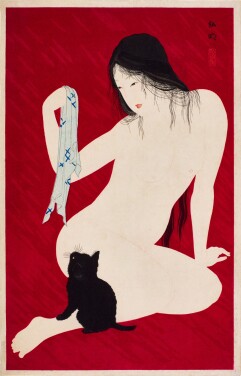T aking place this 9–16 December 2022, Sotheby's is pleased to present Fine Japanese Prints. Renowned ukiyo-e artists such as Hokusai, Hiroshige, Utamaro, Harunobu and Hasui take centre stage with a selection of Japan's quintessential designs.
Auction Highlights

Japan’s supernatural realm is rich, complex and somewhat confounding. Thanks to a form of spiritual secularism where ideas of Shinto animism, Buddhist enlightenment and Confucian morality converge, all elements of life hold a soul. As such, the nation’s mythology is filled with shapeshifting deities, vengeful ghosts and multifarious yokai, who might be benevolent, mischievous, or bloodthirsty.
This cavalcade of spirits holds various significance, including bestowing good fortune, maintaining nature’s intrinsic balance, conveying moral warnings, or simply creating chaos. Such beings were also a huge source of inspiration for ukiyo-e artists, who kept up with an insatiable demand for woodblock prints – which reached its zenith in the 19th century – by mining stories of myth and legend.
Alongside images of stunning courtesans and lush landscapes, these sensational scenes reflected the popular culture of urban Edo (modern-day Japan) where commerce, entertainment and pleasure-seeking reigned supreme. Just as superhero and horror movie franchises dominate the box office today, these epic, interwoven stories ignited the public imagination through lavishly pigmented prints, as well as Kabuki and Noh plays.
One of the most popular figures was the ferocious samurai Minamoto no Yorimitsu (also known as Raiko), who was depicted by early ukiyo-e master Hishikawa Moronobu and later the immensely influential Utagawa school. Along with his ever-present companions known as the Four Guardian Kings, Yorimitsu encountered various vicious beasts known as oni. These included the Shutendoji, the ‘drunken demon’ of Kyoto who had a habit of abducting young women; an enormous magical snake conjured by the bandit Hakamadare; and the Earth Spider, a horrifying creature known for spinning dark magic wherever it went.
These dramatic tales were perfectly suited to the dynamic, graphic sensibilities of woodblock, where scenes often stretched over several prints and the narratives lent themselves to vignettes of sensational, densely packed action. This is no better demonstrated than in Utagawa Yoshifa’s triptych The Ghost of Akugenta Taking Revenge on Nanba at the Nunobiki Waterfall. Here, the spirit of a great warrior appears in a blaze above his own corpse, to take revenge on his murderer. Slices of searing hot light create both a powerful sense of perspective and explosive violence, which is in direct contrast to the serene, cobalt blue tones of the waterfall beyond.
While these ancient tales were embedded in the historical fabric of the nation’s folklore, their symbolism could also hold contemporary political resonance. For example, Utagawa Kuniyoshi’s Earth Spider prints are widely considered to be thinly veiled commentary on the Tokugawa government’s punitive Tenpo Reforms (1841-3), which introduced strict restrictions on individual freedoms on the grounds of morality and frugality, including censoring art and theatre.
Along with these direct retellings of well-known myths, artists also harnessed the enormous popularity of the stage. Yakusha-e or ‘actor pictures’ depicted Kabuki stars in their best-known roles, which often included ghosts.
These could be rather gruesome portrayals including bloodied bodies, as is the case in Kunisada depiction Ichikawa Kodanji IV as the ghost of Menoto Igarashi, and horrible disfigurements as seen in Shunkosai Hokushu’s print The Actor Onoe Kikugoro II as the Ghost of Oiwa. This chilling tale, in which a woman dies after using a disfiguring face cream given to her by a rival for her husband’s affections, still resonates. It is said to have inspired the countenance of the ghost in Hideo Nakata terrifying film The Ring (1998).
While these spectral figures were immensely popular, more subtle allusions to the spiritual world were also celebrated. In Hokusai’s Giant Bamboo Appearing from the Snow, for example, the farmer’s shock at seeing a gigantic plant thrive in winter is palpable through his flexed body and outstretched hands. Likewise, in Utagawa Hiroshige’s night-time vision of gathering foxes, the mystical significance might not be immediately apparent. However, on closer inspection, each animal can be seen clutching a flame, in an allusion to the natural phenomenon of kitsunebi or ‘ghost lights’, which farmers used to predict the harvest. This animalistic phantasm is a perfect example of how Japanese folklore served as a powerful and often venerated force, where spirits exist not in some distant world, but the within the realities of everyday life.
Holly Black is a writer and editor based in London. She is the author of Artists on Art: How They See, Think and Create (2022).
Read Less





































![View 1 of Lot 149: Kawase Hasui (1883-1957) | Snow at Hie Shrine (Shato no yuki [Hie jinja]) | Showa period, 20th century](https://sothebys-com.brightspotcdn.com/dims4/default/523ad79/2147483647/strip/true/crop/4849x7211+0+0/resize/253x376!/quality/90/?url=https%3A%2F%2Fsothebys-md.brightspotcdn.com%2F35%2F9f%2F704c68644b77b5f28fb3f7002c87%2Fl22227-cfstb-t3-01a.jpg)












































